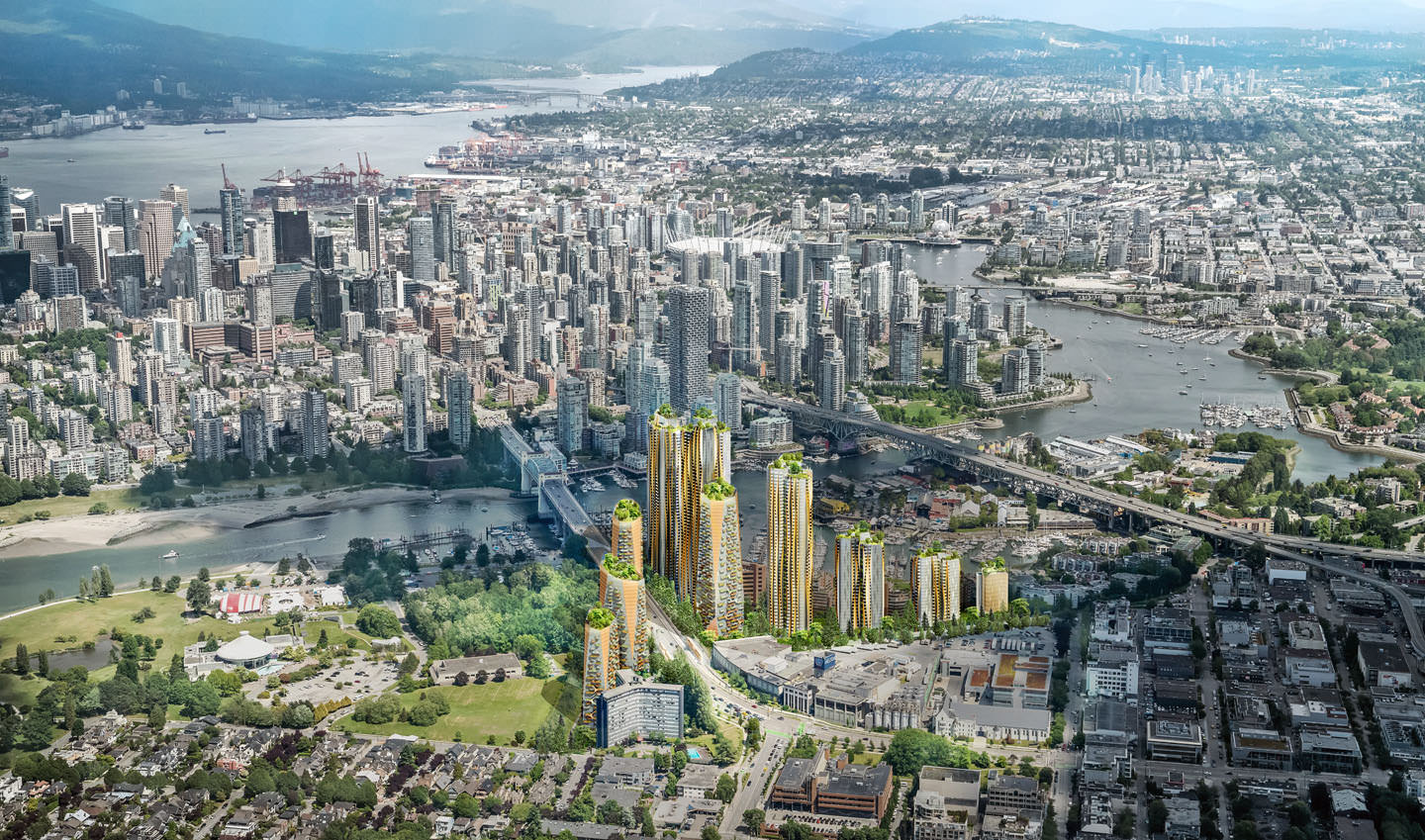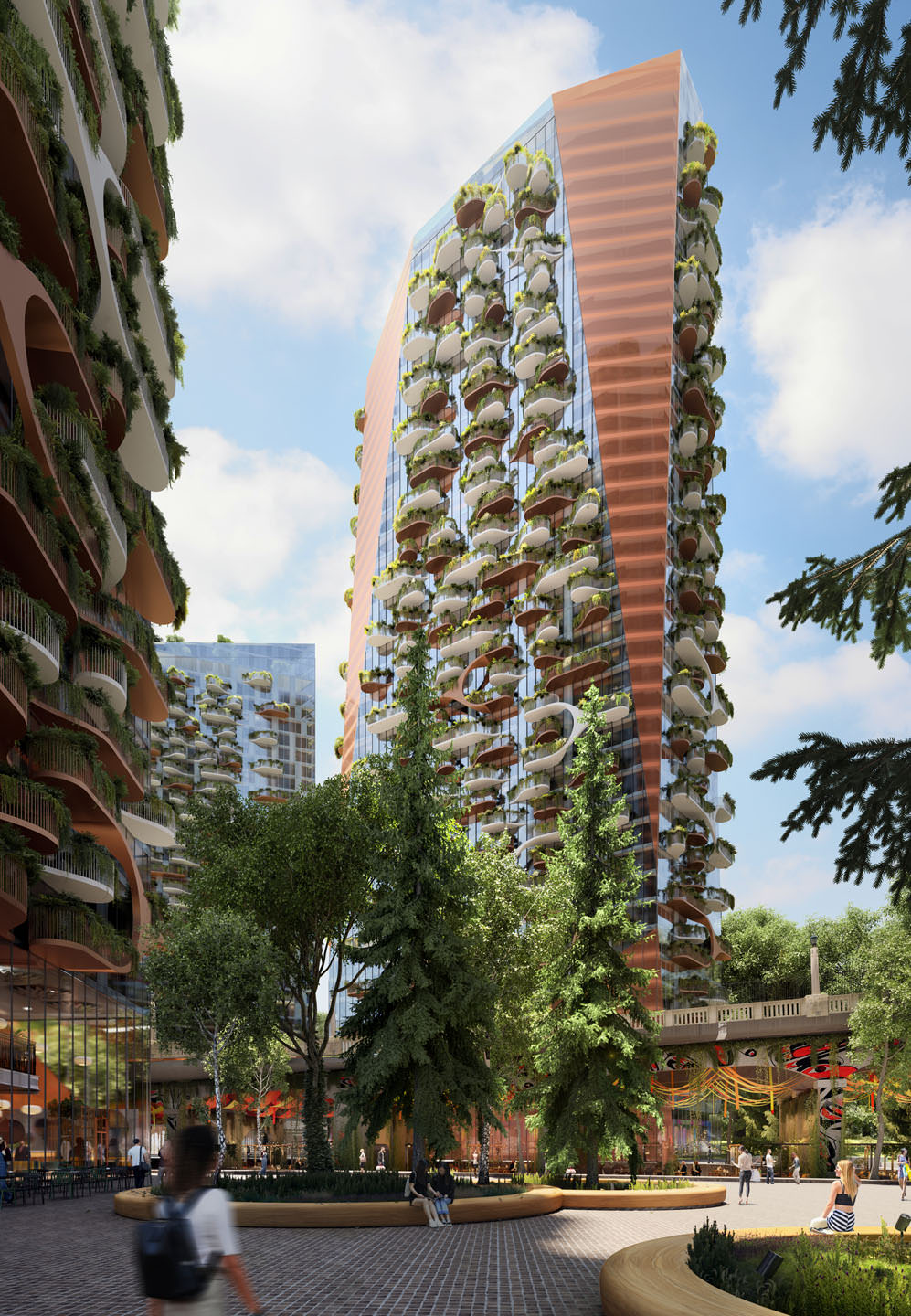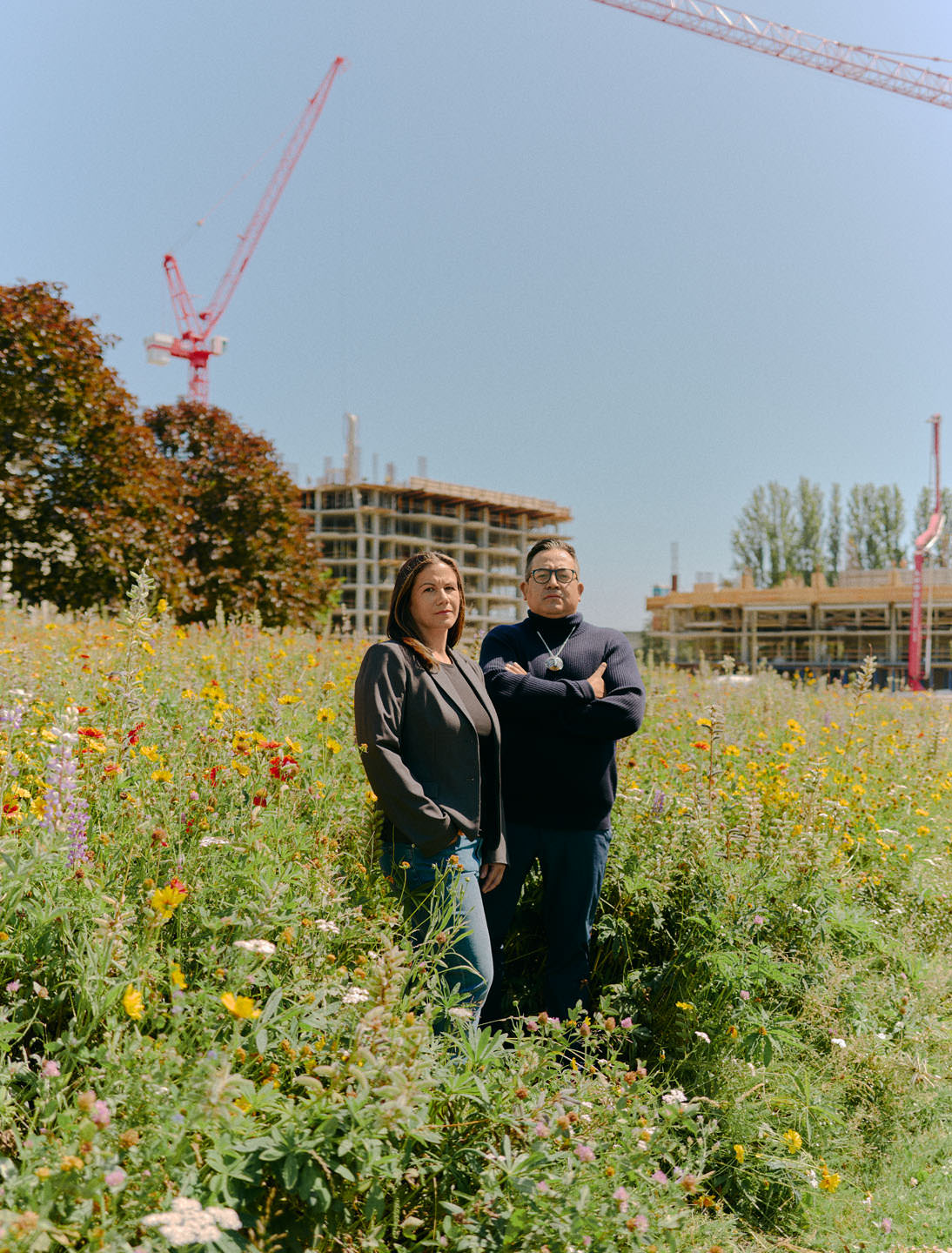Flanking the southern end of the Burrard Street Bridge, an ambitious new housing development of glass and copper glimmers in the sunshine. Over the next few years, this neighbourhood of 11 towers and 6,027 rental homes—including more than 1,200 below-market units—will rise with slope-sided buildings evoking mountains and taller skyscrapers suggesting vertical longhouses. “Sen̓áḵw is going to be a gateway to downtown Vancouver,” says Sxwíxwtn (Wilson Williams), spokesperson and council member of the Sḵwx̱wú7mesh Úxwumixw (Squamish Nation), describing his nation’s plans for this modern village.
Featuring 7.5 acres of shared public space, the landscape around the towers will integrate Squamish Nation culture through gardens planted with native species, millions of dollars in Coast Salish art, and amenities such as gathering and recreation spaces including play structures. The nation aims to create a more sustainable style of housing for both its urban members and the public by designing a neighbourhood that’s highly densified, with a net-zero heating and cooling system, an expanded transit hub, and a focus on cycling.
Sxwíxwtn predicts that Sen̓áḵw will become not just a place to live, but a destination neighbourhood for recreation, connection, and cultural learning. “Sen̓áḵw means ‘the start of something beautiful,’” he explains. “That’s always been this land’s role.”
For many Vancouverites, the original story of Sen̓áḵw has been obscured. The ancient village site, whose name can be interpreted as “the place inside the head of False Creek,” is one of many culturally significant locations across the Lower Mainland with stories that were nearly lost. Once a place of abundance where Squamish families fished, hunted, and harvested, Sen̓áḵw was also a sacred gathering place for meetings and celebrations among the Indigenous Nations who shared the region. Then, in 1877, federal officials enclosed the village within the 82-acre Kitsilano Indian Reserve no. 6. In the years that followed, this land base was expropriated and encroached upon until 1913, when the government illegally pushed the residents onto a barge and burned the village behind them.
“This set the Nation on our current path,” Sxwíxwtn says. “We were forced to integrate in today’s world to protect everything we had left and to learn to fight for what was taken away.”

Aerial view of Sen̓áḵw.
Since the mid-1960s, the Squamish, Musqueam, and other nations throughout B.C. have engaged in negotiations and lawsuits to reclaim their rightful lands. Even when a nation wins back their land (such as the return to the Squamish of the 10.48 acres that make up modern Sen̓áḵw in 2002), challenges created by the federal Indian Act make it difficult to transform property into economic security.
Regulatory changes to the federal First Nations Commercial and Industrial Development Act (FNCIDA) and other legislation have helped. But according to Jennifer Podmore Russell, executive vice-president of real estate and development for Nch’ḵay̓, the economic development corporation for the Squamish Nation, the initiative for finding solutions for the Squamish came from the people themselves.
Realizing they needed partners who would listen and take time to understand and respect their vision, representatives from the Squamish Nation’s members worked with Revery Architecture to develop a master plan for the site. Because the development is on reserve land, the approval process is different from city developments. It requires a vote from nation members rather than feedback from city residents. In December 2019, the membership voted overwhelmingly in favour of building Sen̓áḵw and in favour of forming a 50-50 business partnership with local developer Westbank.
“Development can create prosperity for future generations,” Podmore Russell explains. “But it’s more than building new housing. It’s creating jobs and entrepreneurial opportunities. It’s preserving the culture in a modern way for the generations to come.”

Sen̓áḵw towers.
While Sen̓áḵw will be one of the first visible changes to Vancouver’s glittering cityscape, at least eight more Indigenous-led projects across Metro Vancouver are poised to add dozens of towers and a combined 29,000 homes to the skyline. These developments will forever change and Indigenize a place that once sought to erase them.
Sacred Waters, an economic development company jointly owned by the Katzie, Kwantlen, and Semiahmoo First Nations, has proposed one of the newest projects with nearly 1,500 homes and four towers to be constructed on their property in Langley. MST, the development company co-owned by the Musqueam, Squamish, and Tsleil-Waututh Nations, has six projects underway and also served as a model for Sacred Waters.
Born out of an ancient relationship rekindled during the 2010 Olympics, the three nations that came together in MST are now a development and cultural powerhouse. Their best-known project plan is for ʔəy̓alməxʷ/Iy̓álmexw/Jericho Lands, a 90-acre, high-density site where up to 13,000 homes and 20 acres of parkland will tell the story of the people who once had trails running through the forest to their villages and gathering spaces.
Also in the works is the Heather Lands, a 21-acre site that’s slated to become χews̓ tə na̓ šxʷtə̕ na̓ χətəl ̕ / X a̱ ws̓ uÚxwumixw, a neighbourhood with 2,600 homes, a winding forested trail, and a cultural centre. In Burnaby’s kʷasən Village (formerly the Willingdon Lands), approximately 5,000 new homes will rise on 40 acres of land. Meanwhile, plans for the former Liquor Distribution Branch site on East Broadway are just getting underway.
“People say that Indigenous values don’t fit with modern development, but we’re modern people. We can build those values in.” —Mindy Wight
For Vancouver’s planning department, this Indigenous building boom has been a much-needed helping hand with the housing crunch, as well as an opportunity to test its commitment to becoming a city of reconciliation. Using Vancouver’s 2022 UNDRIP Strategy, which provides a systematic framework for working government-to-government, the planning department aims to take a respectful and collaborative approach to development. “We’ve learned to be more flexible around our policies and bylaws, to enable the nations to achieve their vision but also to achieve the city’s goals,” says Matt Shillito, the director of the City of Vancouver’s special projects office and interim director of planning.
Shillito says part of this new way of doing things has also included making time for city officials to learn about each nation’s history and culture, and to start to understand what the land means to them. “There’s also a greater emphasis on working with the land in terms of ecosystems and sustainability,” he says, “such as managing the site’s stormwater in a traditional way.”
For Mindy Wight, chief executive officer of Nch’ḵay̓ and a Squamish Nation member, this new openness to traditional teachings and the rising public interest in the Squamish Nation’s story and culture are part of what makes a project like Sen̓áḵw so exciting. “People say that Indigenous values don’t fit with modern development, but we’re modern people. We can build those values in.”
Wight continues, listing Squamish values-turned-initiatives meant to benefit the people at the worksite: “We work collaboratively and support our workforce which is diverse and inclusive. There’s also a Squamish centre on site, where Indigenous workers can go talk to elders.” She highlights the innovations for the environment: “The reduced parking spots—that’s intentional—to encourage the use of bikes and transit. We’re using a district energy system that will harness heat and cooling from the sewers under the towers.”
Looking ahead to when Sen̓áḵw is an established neighbourhood, Wight imagines it won’t feel that different from other communities—with shops, offices, and recreation. “I think it’ll be a really special place of cultural significance as well,” she says. Both for Squamish families, like some of the workers on site who already see themselves as building their future, and for other Vancouverites. “People are going to be proud to call it home, because it embodies the culture and teachings of Squamish people throughout. It will feel inclusive and positive.”
Pausing, almost as though giving a moment for the story of Sen̓áḵw to travel beyond the present’s dusty whirlwind of cranes and construction, Wight is silent. Sen̓áḵw had been a beautiful place of monumental cedars, clear salmon streams, and sandy shores that was loved and stewarded and had everything the people needed. Shell midden deposits associated with pre-contact occupation were found just before the construction started—something that seems impossible given the land’s long industrial use. It was as though Sen̓áḵw had been waiting for the people to return.
“It’s going to be beautiful,” she says. “I hope it advances healing and prosperity for the Squamish people.”
Read more from our Autumn 2024 issue. Hair and makeup by Melanie Neufeld for Lizbell Agency. Photographer’s Assistant: Kitt Woodland.









